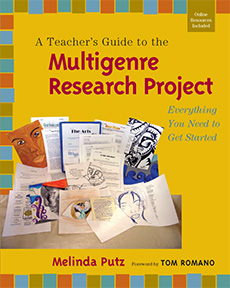A Fresh Way to Engage Students in Research
A Teacher’s Guide to the Multigenre Research Project: Everything You Need to Get Started
By Melinda Putz
(Heinemann Press, 2020 – Learn more)
Reviewed by Erin Corrigan-Smith

By encouraging students to seek out learning they are most interested in, engagement is increased, and learning becomes more meaningful.

Though often used in the Social Studies or Science classrooms, MGRP lends itself to activating student interest in almost any classroom setting and with almost any subject.
A new approach to an old concept
Most disciplines have standards that involve research of some kind. The MGRP offers an alternative to the traditional research essay or poster-board project. It’s a fresh way to excite students to get them to take ownership of what they want to research, while also hitting those all-important research standards.
The very nature of the MGRP requires students to synthesize their learning through artifacts from multiple genres, i.e., poetry, essay, cartoons, etc., and this synthesis gets students to that all-important Depth of Knowledge Level 4 many schools and districts aspire to.
For any teacher interested in offering an MGRP for student choice, but who is afraid of administrative kickback, there is an entire chapter (10) dedicated solely to the research and standards behind the MGRP.
The MGRP is something to offer for older grades – at least grade 6, with some modifications. By the time students have reached high school, they should already possess the basic skills for researching topics, so implementing the MGRP will be a relatively painless transition. (See these ideas for middle school from Jeremy Hyler.)
Though not a simple task, implementing the MGRP allows students to follow their own interests, so they are more determined to complete the projects they have chosen. This is not a stuffy essay! Rather, it is a chance for students to truly show their learning and mastery on any topic they choose. In the words of Putz:
Nearly all of the ideas I have included in this book have been created, tried, and revised over a period of about ten years. Although I’ve included lots of handouts and step-by-step instructions, I believe the teaching of this project should be in no way formulaic. The multigenre project should be all about exploration, innovation, and individuality (p. 14).
Resource packed chapters
The book is deceptively thin, but it packs a wallop in information! Each chapter has been well organized to get to the point, and reach it quickly, so that the teacher can get students started as soon as they are ready. The text also includes access to online materials, provided through the Heinemann website, for download and immediate implementation. The samples include handouts, lesson plan ideas, and exemplars for students to see.
Each step of the process is well thought out and well implemented to make the most use of classroom time. Essentially, the book is the layout for the project and each chapter builds upon the one before it.
New to MGRP? Start with Chapter 11
For anyone new to the MGRP idea, Chapter 11 is where you would want to begin. This chapter lays out the proposed schedule, troubleshooting ideas, and even a process for using the MGRP as a group project. After reviewing the information in Chapter 11, return to Chapter 1 for a run-down of what, exactly, an MGRP is, and a chart on how it differs from a traditional research project.
For those teachers who are tired of fighting an uphill battle to get students to complete a research essay or presentation, this is a viable option that offers a chance for students’ buy in while also challenging them to dig deeper and find true meaning in what interests them most.
Erin Corrigan-Smith is a secondary ELA teacher in a suburb of Atlanta. She has a B.A. and M.A. in English, and her focus of study is children’s literature. She has recently returned to school to earn an Ed.D. in Reading and Literacy. In her downtime, she enjoys going to her family’s cabin in the North Georgia mountains with her husband and dog to read, complete her never-ending piles of homework, and relax.






























